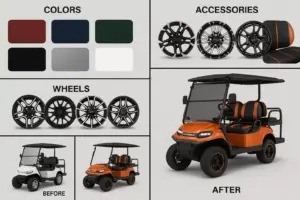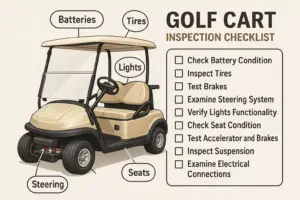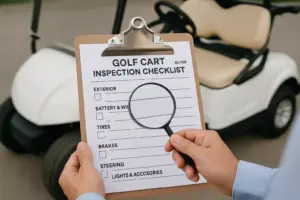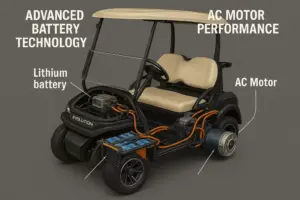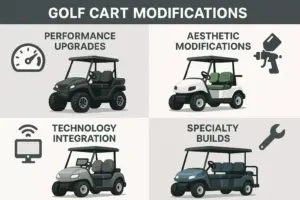Used Golf Carts for Sale: How to Spot a Great Deal vs. a Lemon
The golf cart market has exploded in 2025, with sales reaching record highs as more communities embrace these versatile vehicles for everything from neighborhood transportation to recreational adventures. But here’s the catch: not all used golf carts are created equal. While some represent incredible value propositions, others are money pits waiting to drain your wallet. The difference between a great deal and a costly mistake often comes down to knowing what to look for before you buy.
Key Takeaways

- Battery condition is everything – The battery pack can cost $800-$2,500 to replace, making it the most critical component to inspect
- Motor and controller health determines long-term reliability and performance in electric models
- Frame and body integrity affects both safety and resale value significantly
- Age and usage history provide crucial context for pricing and expected lifespan
- Professional inspection can save thousands by identifying hidden problems before purchase
Understanding the Golf Cart Market in 2025 🏌️♂️
The used golf cart market has become increasingly sophisticated, with prices ranging from $2,000 for older electric models to $15,000+ for premium gas-powered carts with luxury features. This wide price range means opportunities abound for savvy buyers, but it also creates potential pitfalls for the unprepared.
Types of Golf Carts Available
Electric Golf Carts
- Lower operating costs
- Quieter operation
- Environmentally friendly
- Require battery maintenance
Gas-Powered Golf Carts
- Longer range capabilities
- Faster refueling
- More power for hills
- Higher maintenance requirements
Red Flags: Spotting a Lemon 🚩
Battery Warning Signs (Electric Carts)
The battery system represents the heart of any electric golf cart. Here’s what to watch for:
Visual Inspection Red Flags:
- Corrosion buildup around terminals
- Cracked or swollen battery cases
- Loose or damaged cables
- Water levels below recommended marks
Performance Indicators:
- Cart struggles on inclines
- Significantly reduced range
- Slow acceleration
- Inconsistent power delivery
Expert Tip: “A battery load test is worth its weight in gold. If the seller won’t allow testing, walk away immediately.” – Mike Rodriguez, Certified Golf Cart Technician
Motor and Controller Issues
Troublesome Symptoms:
- Jerky or erratic movement
- Unusual noises during operation
- Overheating after short use
- Burnt electrical smell
Frame and Structural Problems
Critical Inspection Points:
- Rust or corrosion on frame components
- Bent or damaged suspension
- Cracked body panels
- Misaligned wheels or axles
Green Flags: Identifying Great Deals ✅

Well-Maintained Battery Systems
Positive Indicators:
- Clean, corrosion-free terminals
- Proper water levels in all cells
- Recent maintenance records
- Strong performance on test drive
Quality Documentation
Valuable Paperwork:
- Service records showing regular maintenance
- Battery replacement history
- Original purchase documentation
- Warranty information (if applicable)
Honest Seller Behavior
Trust Indicators:
- Allows thorough inspection
- Provides maintenance history
- Answers questions directly
- Offers test drive opportunity
The Complete Inspection Checklist 📋
Pre-Purchase Visual Assessment
Exterior Inspection:
- Body condition – Check for dents, scratches, and rust
- Tire wear patterns – Uneven wear indicates alignment issues
- Seat condition – Look for tears, fading, or excessive wear
- Lights and accessories – Test all electrical components
Under-the-Hood Examination:
- Battery compartment cleanliness
- Wiring condition and organization
- Motor mounting and condition
- Controller connections
Performance Testing
Test Drive Essentials:
- Acceleration responsiveness
- Braking effectiveness
- Steering precision
- Hill climbing ability
- Range assessment
🏌️ Golf Cart Value Calculator
Estimated Fair Market Value
Pricing Guidelines and Market Values 💰
Electric Golf Cart Pricing Matrix
| Age Range | Excellent Condition | Good Condition | Fair Condition |
|---|---|---|---|
| 0-2 years | $8,000-$12,000 | $6,500-$9,500 | $5,000-$7,500 |
| 3-5 years | $5,500-$8,000 | $4,500-$6,500 | $3,500-$5,000 |
| 6-10 years | $3,500-$5,500 | $2,800-$4,200 | $2,200-$3,200 |
| 10+ years | $2,000-$3,500 | $1,500-$2,800 | $1,000-$2,000 |
Gas Golf Cart Pricing Matrix
| Age Range | Excellent Condition | Good Condition | Fair Condition |
|---|---|---|---|
| 0-2 years | $10,000-$15,000 | $8,000-$12,000 | $6,500-$9,500 |
| 3-5 years | $7,000-$10,000 | $5,500-$8,000 | $4,500-$6,500 |
| 6-10 years | $4,500-$7,000 | $3,500-$5,500 | $2,800-$4,200 |
| 10+ years | $2,500-$4,500 | $2,000-$3,500 | $1,500-$2,500 |
Negotiation Strategies That Work 🤝
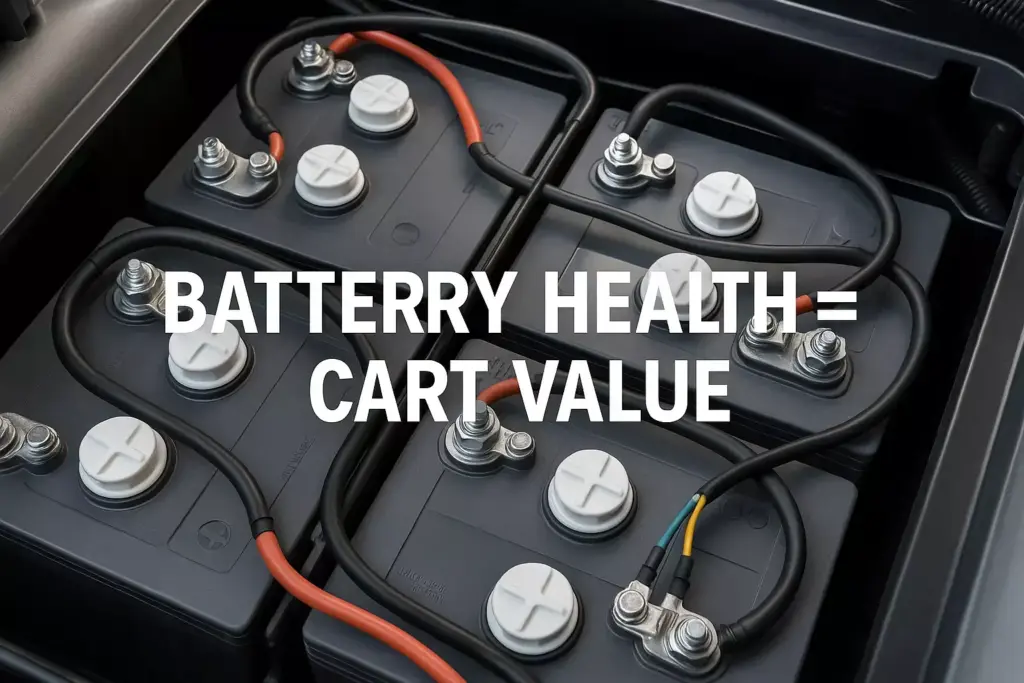
Research-Based Approach
Preparation Steps:
- Research comparable sales in your area
- Identify specific issues during inspection
- Calculate repair costs for known problems
- Determine your maximum budget
Effective Negotiation Tactics
Opening Moves:
- Start with a reasonable but low offer
- Reference specific condition issues
- Mention comparable sales data
- Express genuine interest while maintaining alternatives
Common Negotiation Scenarios:
Battery Replacement Needed:
- Electric cart battery replacement: $800-$2,500
- Negotiate reduction equal to replacement cost
Cosmetic Issues:
- Minor body damage: $200-$800 reduction
- Seat replacement: $300-$600 reduction
- Paint touch-up: $150-$400 reduction
Financing and Payment Options 💳
Traditional Financing Sources
Bank and Credit Union Loans:
- Typically offer lowest interest rates
- Require good credit scores
- May have restrictions on cart age
Dealer Financing:
- More flexible credit requirements
- Higher interest rates
- Convenient one-stop shopping
Alternative Payment Methods
Cash Purchases:
- Strongest negotiating position
- No interest charges
- Immediate ownership
Personal Loans:
- Flexible use of funds
- Fixed payment terms
- Higher rates than secured loans
Maintenance Costs and Ownership Considerations 🔧
Annual Maintenance Budgets
Electric Golf Carts:
- Routine maintenance: $200-$400 annually
- Battery replacement: Every 4-6 years
- Motor service: Every 3-5 years
Gas Golf Carts:
- Routine maintenance: $300-$600 annually
- Engine service: Annual tune-ups required
- Fuel costs: $200-$500 annually
Long-Term Ownership Costs
5-Year Ownership Projection:
Electric Cart ($6,000 purchase):
- Maintenance: $1,500
- Battery replacement: $1,200
- Total cost: $8,700
Gas Cart ($7,000 purchase):
- Maintenance: $2,000
- Fuel: $1,500
- Engine work: $800
- Total cost: $11,300
Legal and Insurance Considerations ⚖️

Registration Requirements
State Variations:
- Some states require registration and insurance
- Age restrictions for operators
- Safety equipment mandates
Insurance Options
Coverage Types:
- Liability insurance for property damage
- Comprehensive coverage for theft/damage
- Medical payments for injury protection
Cost Expectations:
- Basic liability: $100-$300 annually
- Comprehensive coverage: $200-$500 annually
Where to Find the Best Deals 🎯
Online Marketplaces
Top Platforms:
- Facebook Marketplace – Local deals, easy communication
- Craigslist – Wide selection, negotiable prices
- eBay Motors – Auction opportunities, buyer protection
- Golf cart specialty sites – Expert sellers, detailed listings
Local Sources
Physical Locations:
- Golf course pro shops – Well-maintained trade-ins
- Dealership lots – Warranty options, financing
- Estate sales – Potential bargains, unique finds
- Community bulletin boards – Local neighborhood sales
Seasonal Timing Advantages
Best Buying Seasons:
- Late fall/winter – Lower demand, better prices
- End of golf season – Courses selling inventory
- Economic downturns – Motivated sellers
Final Inspection and Purchase Process ✅
Professional Inspection Services
When to Hire Professionals:
- High-value purchases ($8,000+)
- Complex electrical systems
- Uncertainty about condition
- Peace of mind investment
Inspection Costs:
- Basic inspection: $75-$150
- Comprehensive evaluation: $150-$300
- Potential savings: $1,000-$5,000 in avoided problems
Documentation Requirements
Essential Paperwork:
- Bill of sale with detailed description
- Title transfer (if required in your state)
- Maintenance records and warranties
- Registration documents (where applicable)
Post-Purchase Steps
Immediate Actions:
- Schedule maintenance service
- Register with local authorities (if required)
- Arrange insurance coverage
- Create maintenance schedule
Conclusion
Buying a used golf cart doesn’t have to be a gamble when you’re armed with the right knowledge. The key to success lies in thorough inspection, realistic pricing expectations, and patient shopping. Remember that a great deal isn’t just about the lowest price—it’s about finding a reliable cart that meets your needs without hidden surprises.
Your Next Steps:
- Use the inspection checklist provided to evaluate potential purchases
- Research local market prices using the pricing guidelines
- Test drive multiple carts to understand quality differences
- Budget for maintenance costs beyond the purchase price
- Consider professional inspection for high-value purchases
The used golf cart market in 2025 offers excellent opportunities for savvy buyers. Whether you’re looking for basic transportation around your community or a feature-rich recreational vehicle, the perfect cart is out there waiting. Take your time, do your homework, and you’ll drive away with confidence in your purchase.

